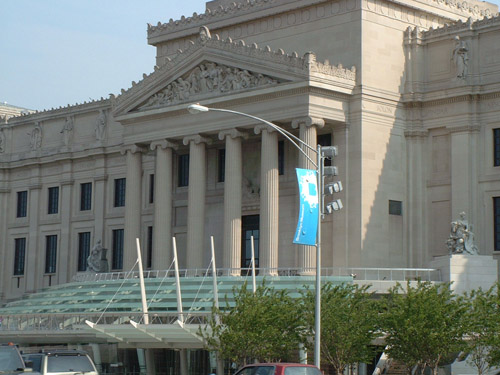 |
 |
What is commonly referred to as "New York City" is actually a group of five boroughs which include Manhattan, Brooklyn, Queens, Bronx and Staten Island. Brooklyn was incorporated as a city in 1834 and in 1898 became part of greater New York City. It remains New York's most populous borough.
The completion of the Brooklyn Bridge in 1883 was followed rapidly by construction and opening of other bridges which connected Manhattan to Brooklyn; the Williamsburg Bridge was opened in 1903 and the Manhattan Bridge, on which construction began in 1901, was opened in 1909. In 1911, a proposal was made to add statues to the pylons on the Brooklyn side of the Manhattan Bridge. In 1913, Daniel Chester French was commissioned to design and oversee the carving of two large statues representing the two boroughs linked by the bridge, Brooklyn and Manhattan. The staues were completed and installed in 1916. The removal of the pylons in 1963 (due to modified traffic patterns) found the statues relocated to the Brooklyn Museum where they can now be found. The recent renovation of the Museum in 2003 was cause for cleaning and restoration of French's massive statues and they now flank the new entrance of the museum.
Like French's "Continents", "Brooklyn" and "Manhattan" are allegorical representations in human form of the character of a geographic location. Each borough has a distinct character and is surrounded by items which reflect some of the industry and culture of each place. Manhattan sits in an aloof posture, reflecting its sense of superiority and dignity. Her foot on a chest (of money? - Mahnattan is a great financial center) and wearing a crown representative of a skyscraper, she holds a winged globe and is surrounded with a Greek torso (representative of the many museums in Manhattan), the bows of three ships and a peacock. Brooklyn, on the other hand, has a stunningly beautiful contenance, her head crowned with a laurel wreath and surrounded by a young boy reading, a church and a lyre. Both statues could not be more different in character yet they so accurately reflect the different aspects of each borough. The statues are carved in granite.
"Brooklyn" and "Manhattan" flank the new front entrance to the Brooklyn Museum (formerly called the Brooklyn Museum of Art) which is easily accessible at the "Eastern Parkway/Brooklyn Museum" stop on the number 2 or 3 New York city subway lines. One can get quite close to Mahnattan and you can also see the back of Manhattan through a window in one of the museum's galleries; Brooklyn, on the other hand, is rather high up and far away and it is much more difficult to view in detail. Both statues sit on a terrace which is open periodically for special events which would lend to much better observation of French's fine work.
All photos below were taken by Douglas Yeo in July 2004.
 This view shows "Brooklyn" as one comes up the stairs out of the Eastern Parkway/Brooklyn Museum stop on the New York City 2 and 3 train lines.
This view shows "Brooklyn" as one comes up the stairs out of the Eastern Parkway/Brooklyn Museum stop on the New York City 2 and 3 train lines. |
 A front view of "Brooklyn."
A front view of "Brooklyn." |
 "Brooklyn" from the front left side showing the young boy reading a book.
"Brooklyn" from the front left side showing the young boy reading a book. |
 A full view of "Brooklyn" from the left.
A full view of "Brooklyn" from the left. |
 This view shows "Brooklyn" from the front right side, showing the church and lyre.
This view shows "Brooklyn" from the front right side, showing the church and lyre. |
 "Manhattan" from the front.
"Manhattan" from the front. |
 A view of "Manhattan" from the front left.
A view of "Manhattan" from the front left. |
 "Manhattan" from the right side. Note the aloof way in which she carries her head.
"Manhattan" from the right side. Note the aloof way in which she carries her head. |
 This view of the back and left side of "Manhattan" was taken through a window in a gallery inside the Brooklyn Museum. It shows some rough elements to the statue which were
not intended to be seen in the original installation on the Manhattan Bridge.
This view of the back and left side of "Manhattan" was taken through a window in a gallery inside the Brooklyn Museum. It shows some rough elements to the statue which were
not intended to be seen in the original installation on the Manhattan Bridge. |
 This front view of the Brooklyn Museum shows French's statues in situ, with "Manhattan" on the left side and "Brooklyn" on the right.
This front view of the Brooklyn Museum shows French's statues in situ, with "Manhattan" on the left side and "Brooklyn" on the right. |
|
All rights reserved. |